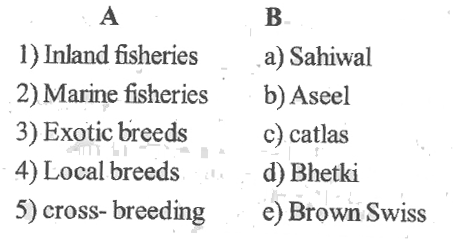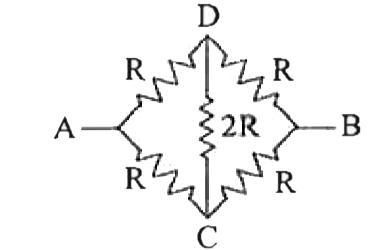Complete Solutions to Physics of chapter MODEL TEST PAPER 5 of Class 12 book with complete answers and questions
| Class 12 | PHYSICS |
| Chapter | MODEL TEST PAPER 5 |
| KCET PREVIOUS YEAR PAPERS | Physics |
| Number Of Questions | 60 |
| Academic Year | 2023-24 |
A moving body of mass m and velocity 3 km/hr collides with a rest body of mass 2m and sticks to it. Now the combined mass starts to move. What will be the velocity of the combined mass ?
View SolutionThe value of `g` on the earth's surface is `980 cm//sec^(2)` . Its value at a height of `64` km from the earth's surface is
View SolutionA boy on a cycle pedals around a circle of 20 metres radius at a speed of `20 "metres"//sec`. The combined mass of the boy and the cycle is 90 kg . The angle that the cycle makes with the vertical so that it may not fall is `(g = 9.8 m//sec^(2))`
View SolutionThe translational kinetic energy of gas molecules for one mole of the gas is equal to
View SolutionHydra can be
View SolutionThe acceleration due to gravity g and mean density of earth `rho` are related by which of the following relations ?
(G = gravitational constant and R = radius of earth)
View SolutionThe angular speed of a fly wheel making 120 revolutions / minute is
View SolutionA block rests on a rough inclined plane making an angle of `30 ^@` with the horizontal . The coefficient of static friction between the block and the plane is 0.8 If the frictional force on the block is 10 N the mass of the block is `" "(g=10 ms ^(-2))`
View SolutionThe mass of ship is `2 xx 10^7` kg. On applying a force of `25xx10^5` N, it is displaced to 25 metres, the speed of ship is
View SolutionA convex lens of focal length `f` is put in contact with a concave lens of the same focal length. The equivalent focal length of the combination is :
View SolutionStationary waves are setup in an air column. Velocity of sound in air is `330 ms^(-1)` and frequency is `165 Hz`. The distance between two successive nodes is
View SolutionFrequency of audible sound waves ranges between 20 Hz and 20 KHz. If the velocity of sound in air is 320 m/s, the range of the wavelengths of the sound in air is
View SolutionWhat is responsible for the blue colour of the solution of alkali metali in liquid ammonia? Give chemical equation also.
View SolutionA stationary point source of sound emits sound uniformly in all directions in a non absorbing medium. Two points P and Q are at a distance of 4 m and 9 m respectively from the source. The ratio of amplitudes of the waves at P and Q is
View SolutionA train blowing its whistle moves with a constant velocity `v` away from an observer on the ground. The ratio of the natural frequency of the whistle to that measured by the observer is found to be `1.2`. If the train is not rest and the observer moves away from it at the same velocity, this ratio would be given by
View SolutionA plane wave is described by the equation `y = 3 cos (x/7 - 10 t - pi/6)`.
The maximum velocity of the particles of the medium due to this wave is
View SolutionA source of sound S is moving with a velocity 50 m/s towards a stationary observer. The observer measures the frequency of the source as 1000 Hz. What will be the apparent frequency of the source when it is moving away from the observer after crossing him : the velocity of soudn in the medium is 350 m/s .
View SolutionIf velocity of sound waves of 300 Hz frequency is v m/sec, then the velocity of sound wave of 150 hertz frequency is
View SolutionFind the number of beats produced per sec by the vibrations `x_1=A sin (320 pi t)` and `x_2=A sin(326 pi t)`.
View SolutionWhat are photodiodes used for ?
View SolutionTo observe diffraction, the size of the obstacle
View SolutionIf two light waves having same frequency have intensity ratio `4:1` and they interfere, the ratio of maximum to minimum intensity in the pattern will be
View SolutionIn Young's double slit experiement when wavelength used is `6000Å` and the screen is `40cm` from the slits, the fringes are `0.012cm` wide. What is the distance between the slits?
View SolutionDispersive power of prism material is
View SolutionThe reaction `5^(B^(8))rarr4^(Be^(8))` takes place due to
View SolutionMatch the following Column - A and Column - B

View SolutionThe unit of absolute permittivity is
View SolutionThe electric intensity at a point distant 1 m from the centre of a sphere of radius 25 cm in air is `10^(4)N//C`. The surface density of the charge on the surface of sphere is
View SolutionA positive charge `Q` is placed at the centre `O` of a thin metalic spherical shell. Select the correct statements from the following:
(i) The electric field at any point outside the shell is zero
(ii) The electrostatic potential at any point outside the shell is `(Q)/(4 pi epsilon_(0) r)` , where `r` is the distance of the point from `O`
(iii) The outer surface of the spherical shell is an equipotential surface
(iv) The electric field at any point inside the shell , other than `O` , is zero
View SolutionAn e.m.f. of `15` volt is applied in a circuit containing `5` henry inductance and `10` ohm resistance. The ratio of the current at time `t=oo` and at `t=1` second is
View SolutionEqual charges Q are placed at the four corners A, B, C, D of a square of length a. The magnitude of the force on the charge at B will be
View SolutionIn the circuit shown

View SolutionIn the following circuit in state of resonance, which statement is correct?

View SolutionA bar of diamagnetic substance is placed in a magnetic field with its length making angle `30^@` with the direction of the magnetic field, the bar behaviour is given by the statement ?
View SolutionAn electron of mass `m` and charge `e` is accelerated from rest through a potential difference `V` in vacuum. The final speed of the electron will be
View SolutionWhat will be the equivalent resistance between the two points A and D?

View SolutionTwo very thin metallic wires placed along `X` and `Y` axes carry equal currents as shown `AB` and `CD` are lines at `45^(@)` with the axes having origin at `O` the magnetic field will be zero on the line

View SolutionThe electrochemical equivalent of magnesium is `0.126 mg//C` . A current of 5 A is passed in a suitable solution for 1 hour . The mass of magnesium deposited will be
View SolutionAcrolein test is positive for
View SolutionA particle `A` has chrage `+q` and a particle `B` has charge `+4q` with each of them having the same mass `m`. When allowed to fall from rest through the same electric potential difference, the ratio of their speed `(v_(A))/(v_(B))` will become
View SolutionA solenoid is at potential difference 60 V and current flows through it is 15 ampere , then the resistance of coil will be
View SolutionAn electron emits energy
View SolutionTwo particles `X` and `Y` having equal charges, after being acceleration through the same potential difference, enter a region of uniform magnetic field and describe circular paths of radii `R_1` and `R_2`, respectively. The ratio of the mass of `X` to that of `Y` is
View SolutionIn an `AC` circuit, the current is given by `i=5sin(100t-(pi)/2)` and the `AC` potential is `V=200sin(100t)`volt. Then the power consumption is
View SolutionThree bulbs of 40 W, 60 W and 100 W are arranged in series with 220 V. The maximum light is obtained from which bulb?
View SolutionEquivalent resistance between A and B in the given circuit will be

View SolutionNuclear forces are
View SolutionThe first line in the Lyman series has wavelength `lambda`. The wavelegnth of the first line in Balmer series is
View Solution`1 g` of hydrogen is converted into `0.993 g` of helium in a thermonuclear reaction. The energy released is.
View SolutionIf the kinetic energy of a moving particle is E , then the de-Broglie wavelength is
View SolutionThe mass number of He is `4` and that for suphur is `32`. The radius of sulphur nuclei is larger than that of helium by
View SolutionIf the binding energy per nucleon in `L i^7` and `He^4` nuclei are respectively `5.60 MeV` and `7.06 MeV`. Then energy of reaction `L i^7 + p rarr 2_2 He^4` is.
View SolutionWhat is the threshold wavelength of a metal if the photoelectric work function of the metal is 5 eV?
View SolutionThe same radioactive nucleus may emit
View SolutionOn increases the reverse biase to a large value of in a `PN`- junction diode, current.
View SolutionIn Millikan oil drop experiment, a charged drop of mass `1.8 xx 10^(-14) kg` is stationary between its plates. The distance between its plates is `0.90 cm` and potential difference is `2.0` kilo volts. The number of electrons on the drop is
View SolutionEmission of electrons from a metal surface due to incident radiation is called
View SolutionA potential of 1 million volts is applied to an Xray tube. The wavelength of the X-rays produced is
View SolutionAn `alpha`-particle having energy = 10 meV collides with a nucleus of atomic number 50. The distance of the closest approach is
View SolutionConsider the D–T reaction (deuterium–tritium fusion)
`""_(1)^(2)H + ""_(1)^(3)H to ""_(2)^(4)He + n`
(a) Calculate the energy released in MeV in this reaction from the data:
`m (""_(1)^(2)H) = 2.014102u`
`m(""_1^(3)H) = 3.016049 u`
(b) Consider the radius of both deuterium and tritium to be pproximately 2.0 fm. What is the kinetic energy needed to overcome the coulomb repulsion between the two nuclei? To what temperature must the gas be heated to initiate the reaction? (Hint: Kinetic energy required for one fusion event =average thermal kinetic energy available with the interacting particles = 2(3kT/2), k = Boltzman’s constant, T = absolute temperature.)
View Solution
Physics questions and complete solutions for chapter MODEL TEST PAPER 5 of KCET PREVIOUS YEAR PAPERS of Class 12